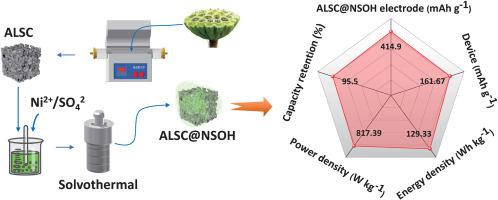Composites made of lotus-seedpod-derived carbon and nickel hydroxide sulfate nanofibers: Advanced materials for supercapacitor electrodes
IF 7.9
2区 工程技术
Q1 CHEMISTRY, PHYSICAL
引用次数: 0
Abstract
Nickel hydroxide sulfate (NSOH) is a promising electrode material for supercapacitors (SCs) for its high redox activity, good cycling stability and low self-discharge rate. However, agglomeration of the nanocrystalline NSOH during charge-discharge cycles reduces the charge transfer rate in the electrodes and through the electrode/electrolyte interfaces and thus degrades capacity and durability. This work reports a strategy to avoid this drawback by embedding NSOH nanofibers (NFs) within activated lotus-seedpod-derived carbon (ALSC) to stimulate synergistic effect between the NSOH and the carbon skeleton toward high-performance electrodes for SCs. The created ALSC@NSOH electrode achieves a desirable specific capacity of 414.9 mAh g−1 (2,987.6 F g−1), which is 2.1 times that of the carbon-free NSOH electrode, and preserves 87.6 % of the initial capacity after 10,000 galvanostatic charge-discharge (GCD) cycles. Encouragingly, the hybrid supercapacitor (HSC) configurated with ALSC@NSOH//ALSC obtains a high energy density of 129.33 Wh kg−1 at 817.39 W kg−1 and an impressive durability of 86.7 % capacity retention for up to 5,000 GCD cycles. This work develops a methodology for transforming waste into energy storage materials, which is beneficial for waste disposal and fossil fuel emissions alleviation and is significant to the environment and circular economy.

莲子炭和硫酸氢氧化镍纳米纤维复合材料:超级电容器电极的先进材料
硫酸氢氧化镍(NSOH)具有氧化还原活性高、循环稳定性好、自放电率低等优点,是一种很有前途的超级电容器电极材料。然而,在充放电循环过程中,纳米晶NSOH的团聚降低了电极中的电荷传输速率以及通过电极/电解质界面的电荷传输速率,从而降低了容量和耐用性。本研究报告了一种避免这一缺陷的策略,通过将NSOH纳米纤维(NFs)嵌入活化莲子衍生碳(ALSC)中,以刺激NSOH和碳骨架之间的协同效应,从而实现高性能的SCs电极。所制备的ALSC@NSOH电极具有414.9 mAh g−1 (2987.6 F g−1)的理想比容量,是无碳NSOH电极的2.1倍,并且在10,000次恒流充放电(GCD)循环后保持了87.6%的初始容量。令人鼓舞的是,配置ALSC@NSOH//ALSC的混合超级电容器(HSC)在817.39 W kg - 1时获得了129.33 Wh kg - 1的高能量密度,并且在高达5,000 GCD循环的情况下具有令人印象深刻的86.7%的容量保留率。这项工作开发了一种将废物转化为储能材料的方法,这有利于废物处理和减少化石燃料排放,对环境和循环经济具有重要意义。
本文章由计算机程序翻译,如有差异,请以英文原文为准。
求助全文
约1分钟内获得全文
求助全文
来源期刊

Journal of Power Sources
工程技术-电化学
CiteScore
16.40
自引率
6.50%
发文量
1249
审稿时长
36 days
期刊介绍:
The Journal of Power Sources is a publication catering to researchers and technologists interested in various aspects of the science, technology, and applications of electrochemical power sources. It covers original research and reviews on primary and secondary batteries, fuel cells, supercapacitors, and photo-electrochemical cells.
Topics considered include the research, development and applications of nanomaterials and novel componentry for these devices. Examples of applications of these electrochemical power sources include:
• Portable electronics
• Electric and Hybrid Electric Vehicles
• Uninterruptible Power Supply (UPS) systems
• Storage of renewable energy
• Satellites and deep space probes
• Boats and ships, drones and aircrafts
• Wearable energy storage systems
 求助内容:
求助内容: 应助结果提醒方式:
应助结果提醒方式:


